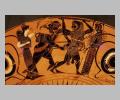
Side B: Herakles and the lion

Side A: view from below

Side B: view from below

Side A: Herakles and Apollo
| Collection: | Munich, Antikensammlungen |
| Summary: | Interior: Gorgoneion. Side A: Herakles and Apollo - Struggle for the tripod. Side B. Herakles and the lion. |
| Ware: | Attic Black Figure |
| Painter: | Attributed to the Lysippides Painter |
| Context: | From Vulci |
| Date: | ca. 525 BC - ca. 515 BC |
| Primary Citation: | |
| Shape: | Kylix |
| Beazley Number: | 302231 |
| Region: | Etruria |
| Period: | Archaic |
Date Description:
Decoration Description:
Interior: Gorgoneion. The gorgon is shown as having a beard and a mustache. The mouth is very wide and the tongue protrudes. Added red is used for the beard and alternating locks of hair. Gorgoneia such as this are probably the most frequently used interior decoration for cups in the last quarter of the sixth century.
Side A: Herakles and Apollo struggle for the tripod while Artemis and Athena look on. Herakles moves off rapidly to the right, looking back over his shoulder at Apollo. Herakles swings his club above his head with his right hand and grasps the tripod in his left. He wears the lionskin belted over a short chiton with a sword and a quiver at his waist. The artist has rather unsuccessfully attempted to show a back view of Herakles, as indicated by the dorsal mane on the lionskin, giving his body a sharp twist. Apollo moves to the left after Herakles, clinging to the tripod with his right hand and grabbing the end of Herakles' club in his left. Apollo is depicted as unbearded, wearing a short chiton, a wreath in his hair, and winged boots. A bow and a quiver are slung over his shoulder. At the left of the composition, Artemis stands, facing right, behind her brother. She wears a peplos, and a polos. She holds her bow in her right hand and her quiver hangs from her shoulder. Athena, at the right of the composition beside Herakles, faces left. She is identified by the snaky aegis over her peplos, as well as by her helmet and spear.
The theme of the struggle for the tripod becomes popular in the last quarter of the sixth century. The composition with four figures is the favored Attic type.
The Lysippides Painter depicts the struggle for the tripod on this vase and on
Side B: Herakles and the lion. Herakles, facing right and standing upright, dispatches the lion with his sword. The lion is also upright on its hind legs, held in Herakles' left arm. Herakles is bearded. He wears a short chiton and a wreath in his hair. His discarded mantle hangs in the background in the middle of the composition. A bow and quiver hang from his shoulder. To the right of this fight, Hermes moves forward gesturing with his right hand. He wears a mantle over a short chiton, boots and a petasos. He carries the kerykeion in his left hand.
Although literary sources such as
The eye-cups decorated by the Lysippides Painter derive from the design invented by Exekias. He decorates the tondo of his eye-cups almost exclusively with gorgoneia, and places figures between the eyes on the exterior.
Sources Used: